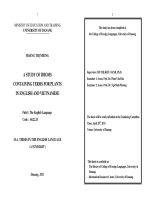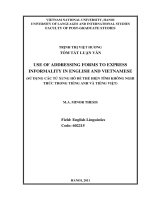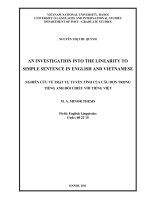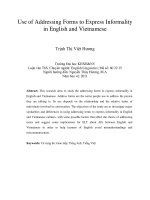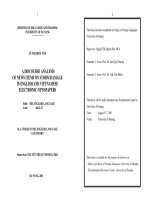Use of Addressing Forms to Express Informality in English and Vietnamese
Bạn đang xem bản rút gọn của tài liệu. Xem và tải ngay bản đầy đủ của tài liệu tại đây (996.22 KB, 14 trang )
Use of Addressing Forms to Express Informality
in English and Vietnamese
Trịnh Thị Việt Hương
Trường Đại học KHXH&NV
Luận văn ThS. Chuyên ngành: English Linguistics; Mã số: 60 22 15
Người hướng dẫn: Nguyễn Thúy Hương, M.A
Năm bảo vệ: 2011
Abstract: This research aims to study the addressing forms to express informality in
English and Vietnamese. Address forms are the terms people use to address the person
they are talking to. Its use depends on the relationship and the relative status of
individuals involved in conversation. The objectives of the study are to investigate major
similarities and differences in using addressing terms to express informality in English
and Vietnamese cultures, with some possible factors that affect the choice of addressing
terms and suggest some implications for ELT about AFs between English and
Vietnamese in order to help learners of English avoid misunderstandings and
miscommunication.
Keywords: Từ xưng hô; Giao tiếp; Tiếng Anh; Tiếng Việt
iv
TABLE OF CONTENT
ACKNOWLEDGEMENTS
CHAPTER: INTRODUCTION 1
1.1. Statement of problem and rationale 1
1.2. Aims and objectives: 1
1.3. Research questions: 1
1.4. Research methodology: 2
1.5. Significance of the study: 2
1.6. Structure of the thesis : 2
CHAPTER 2: LITERATURE REVIEW 4
2.1 Culture, language and communication 4
2.2. Addressing forms 7
2.2.1. Addressing forms and their definitions 7
2.2.2. Features of addressing forms 8
2.2.3. Factors affecting the choice of addressing forms 9
2.3. The use of addressing terms to express informality in English and
Vietnamese 10
2.3.1 The concept of informality 10
2.3.2. The use of addressing forms to express informality in English 11
2.3.3. The use of addressing forms to express informality in
Vietnamese 12
v
CHAPTER 3: METHODOLOGY 14
3.1. Research questions revisited 14
3.2 Selection of participants 14
3.3. Data collection instruments 15
3.4. Data collection procedures 16
3.5. Data analysis 17
CHAPTER 4: RESULTS AND DISCUSTIONS 18
4.1. Results of the study 18
4.1.1. Vietnamese responses 18
4.1.2. English responses 24
4.2. Discussion of the findings 31
4.3. Major similarities and differences between Vietnamese and
English languages and culture in using AFs to express informality32
4.4. Implications for English language teaching ……………………………… … 35
CHAPTER 5: CONCLUSION 37
5.1. Findings of the study revisited 37
5.2. Limitations of the study 38
REFERENCES…………………………………………………………………………39
2
ABSTRACT
This research aims to study the addressing forms to express informality in English and
Vietnamese. Address forms are the terms people use to address the person they are talking to.
Its use depends on the relationship and the relative status of individuals involved in
conversation. The objectives of the study are to investigate major similarities and differences
in using addressing terms to express informality in English and Vietnamese cultures, with
some possible factors that affect the choice of addressing terms and suggest some implications
for ELT about AFs between English and Vietnamese in order to help learners of English
avoid misunderstandings and miscommunication.
Chapter 1: INTRODUCTION
1. Statement of the problem and rationale for the research .
I have decided to undertake a study on Use of Addressing Forms to Express
Informality in English and Vietnamese.
2. Aims and objectives of the study.
In brief, the study would seek to answer the following questions:
- What are the major similarities and differences in using addressing forms to express
informality in English and Vietnamese?
- What are the factors that affect the choice of AFs in two cultures?
3. Methods of the study.
In order to collect data for this study, a survey questionnaire is delivered to 50
respondents in total, 25 Vietnamese and 25 English native speakers. Then, the results obtained
from questionnaires discussed and some useful suggestions for teaching English languge were
recommended.
4. Signification of the study.
The study is hoped to be a useful source for both pedagogical and research purpose.
Specifically, equipped by the outcomes of the study, language teachers and learners may find
the subject matter no longer complicated but motivating uses of AFs to express informality in
English so that English learners can understand deeply addressing forms and can be confident
in using addressing forms successfully.
3
CHAPTER 2: LITERATURE REVIEW
This chapter addresses a review of the literature related to culture, language and
communication and addresssing forms.
1 Culture, language and communication
2. Addressing forms
2.1. Addressing forms and their definitions
2.2. Features of addressing forms
2.3. Factors affecting the choice of addressing forms
3. The use of addressing terms to express informality in English and Vietnamese
3.1 The concept of informality
3.2. The use of addressing forms to express informality in English
3.3 The use of addressing forms to express informality in Vietnamese.
CHAPTER 3: METHODOLOGY
This chapter is devoted to presenting the methodology of the current research,
including the research design, the participants, the data collection instruments and procedure,
and data analysis.
In the preceding chapter, the literature on the research topic was reviewed for the
theoretical basis of the study. In order to lay a practical background for the study, the research
was carried out with strictly justified methods of data collection and analysis.
The study was carried out in 4 months from May to September of 2011 among 50
respondents in total, 25 Vietnamese and 25 English native speakers
3.1. Research questions revisited
To clarify the use of addressing forms to express informality, the study raised specific
questions below:
1. What are the major similarities and differences in using addressing terms to
express informality in English and Vietnamese?
2. What are the factors that affect the choice of AFs in expressing informality in
two cultures?
3.2 Selection of participants
4
The study was carried out with the participation of 50 respondents in total, 25 Vietnamese
and 25 English native speakers respondents. The informants were asked to give information
about their age, and nationality (for English native speakers respondents). because these
factors may affect their choice of addressing forms. The information they supply is useful for
the explanation of differences in the responses.
3.3 Data collection instruments
In order to obtain in-depth, rich data and information for investigating the possible
addressing forms that express informality in two cultures, possible factors that affect the
choice of addressing formss in two cultures, the frequency of addressing forms, the study used
the methods of data collection: questionnaire (conducted in late June).
The questionnaires were made up of two parts: the respondents‟ background information and
the questions.
The respondent‟s background information: with two items for the Vietnamese version
and three items for the English version (one more item of nationality) the main purpose of this
part is to limit the research scope. For example, the information given by the respondents with
their responses would help the researcher to see if the gender has any impacts on the choice of
AFs or not.
The questionnaires:
In the first questionnaire:
- Q1: to seek information on possible AFs that the respondent use to express
informality.
- Q2: to provide respondents types of relations in which AFs are used
- Q3: to provide respondent the categories of settings that respondents use the AFs
(based on the Q1)
In the second questionnaire:
- Q1: provides the respondents with a list of AFs with which AFs are used and
categories of frequency that they used. (based on results of the Questionnaire 1)
- Q2: the level influence of the factors on the choice of AFs.
3.4. Data collection procedure
The procedure of data collection could be put into three stages as follows:
Stage 1: Designing questionnaires
Piloted English & Vietnamese versions.
5
Edited the questions & designed the second version
Stage 2: Delivering questionnaire 1
Distributed Vietnamese version (by the researcher)
Sent English e-version by email & get back via internet.
Stage 3: Designing and delivering questionnaire 2
Questionnaire 2 was develop & distributed to two groups of respondents in the
same manner.
2.5. Data analysis
In this stage the researcher encoded the respondents‟ questionnaires then listed the
study points: first point (1st P): possible AFs, 2nd P: categories of relations (based on the 1st
P), 3rd P: categories of settings (based on the 1st P)
4th P: list of AFs and frequency that respondents used. (base on the 1st P in the first
questionnaire)
5th P: the factors affecting the choice of AFs
The Data collected were tabulated and calculated. The results then were analyzed to
find out the similarities and differences in using AFs to express informality between cultures.
CHAPTER 4: RESULTS AND DISCUSSION.
In this chapter, data was analyzed and discussed, the findings of the study are the answers for
three research questions proposed in the introduction.
Results from the questionnaires
4.1.1. Vietnamese responses
4.1.2. English responses
4.2. Discussion
The previous section has presented in detail the data collected by means of two
questionnaires. This section will present discussion of those data.
The use of AFs to express informality in Vietnamese:
5. Results show that a greater percentage of the participants prefer the use of “pronoun”;
this is followed closely by “bare kinship term”, and “first name terms”. This, however, varies
depending on such factors as „manner of communication‟, „age‟ and „gender‟ and „setting‟
that the participants involved. For instance, table 1 and table 2 show that there is a tendency
6
on the part of participants to address one another with P– a term for informal occasions or
setting, hence the greater percentage for the use of such form. Further analysis of the data
suggests that those that would use AFs at home or public settings are those who often or very
often use P with the others.
6. Regarding the frequency of AFs use, the majority of Vietnamese choose very often
and often as their frequency of expressing informality. More importantly, the choice of AFs to
express informality is clearly affected by such factors as „manner of communication‟, „age‟,
„gender‟ “length of time people have known the other” and „setting‟. Three other factors seem
to have little influence on the choice of AFs, namely “finance power”, “education”, and
“social status”.
7. The use of AFs to express informality in English:
8. Among AFs that are often used to express informality in English, „pronouns‟ are the
most popularly used AFs in English; next come „standard short form of name‟, „terms of
endearment‟. „Bare title‟, „slang‟, „nick name‟ are less favoured.
9. Data collected from the English native speakers respondents show that the settings
where AFs expressing informality are more commonly used in English are “public settings”
and “home”. “Work place”, “library” are less likely to be suitable settings for informality.
“Age” is the settings that do not affect much on the choice of AFs of English native speakers
respondents. However, female English native speakers have tendency on using more AFs to
express informality than male.
10. Concerning factors that affect the choice of AFs in English, it is noted that the most
common factors that affect the choice of AFs are “length of time you have known him/her”,
“manner of communication” and “settings”
11. 4.3 Major similarities and differences in the use of AFs to express informality in
Vietnamese and English speaking cultures.
12. As mentioned earlier in Chapter 2, the Vietnamese addressing system is quite different
from that in English. This section will reflect the similarities and differences in the use of AFs
to express informality in Vietnamese and English
In terms of the number of AFs used to express informality
Data collected from the two groups of respondents shows that the Vietnamese AFs, in
comparison with those in English, are quite different. First and foremost is the personal
pronoun. In Vietnamese, there is a diversity of second-person pronouns expressing different
7
levels of informality (52% of informants very often use, 48% often use). For instance
Vietnamese can use “mày/ chúng (bọn) mày; con/thằng này/kia” to show either intimacy like
“Mưa rồi, mày ạ!” or contempt like “con kia, mang nó vào đây”. On the contrary, in English,
there is only one second-person pronoun “you”, and it can be used in every communicative
circumstances. Analysis of the data suggests that the use of „bare kinship terms‟ in
Vietnamese (32% of informants very often use, 68% often use), to some extent, is more
common than in English (8% of informants very often use, 20% often use). For example, in
Vietnamese language, a stranger person can be addressed by Bk such as “Cô/chị/bà/bác/dì ơi,
cho cháu/em/con 3 lạng nạc vai” hay “Cháu/em thay dầu xe hộ cô/bác/chị/anh với”, but it is
not the same in English.
In both English and Vietnamese languages “first name terms” are used to address
people. In Vietnamese, “first name terms” do not only signal familiarity but also some kind of
respect. Vietnamese never use names to address superior persons, such as parents or older
people, when in English speaking cultures people often call their family members by names
such as “John, Kate”.
Beside using pronouns more frequently, Vietnamese people also use “nick name” to
express their informality. However, in Vietnamese language, “nick name” is used alone or in
combination with a personal pronoun. For example, if you want to meet someone you can ask
by saying: “Dương vịt ơi, mày có thấy con Hoa đâu không”. English addressing systems, like
Vietnamese one, use nickname as a short or cute name used by friends or relatives to show
intimacy.
One noticeable point between Vietnamese and English native speakers respondents is
that English native speakers respondents use “standard short form of name” but it is not in
Vietnamese. English native speakers respondents have tendency to use “standard short form
of name” (with 80% of participants may use) such as “Chris” for “Christian” or “Jill” for
“Jillian”.
One more noticeable phenomenon is that in both Vietnamese and English languages
used „terms of endearment‟(72% of Vietnamese informants use and 64% of English languages
use) are extensive used. To express fondness and influence, both English and Vietnamese
often employ terms of endearment like „honey‟, „dear‟, „sweetie‟, „love‟, „darling‟, „baby‟,
„cutie‟, „cưng‟, „anh yêu‟, „(đằng) ấy‟, „cậu‟, „bồ‟, „bạn‟, „nhóc/nhỏ‟ etc.
Reasons for the differences between English and Vietnamese addressing forms
may be the fact that Vietnamese culture is centered on the family. Therefore, AFs used in
8
communication are very complicated and often indicate the family relationship. However AFs
in English to express informality are larger.
In terms of frequency
Tables 4 and table 10 show the most commonly used AFs in Vietnamese and English.
Pronouns are the most commonly used AFs in both languages. To be more specific, in
English, pronouns, first name terms and standard short form of name are more favored than
other AFs and nick name; slang; bare title; bare kinship term can take part in communicative
events in some way. However, Vietnamese tend to use bare kinship term, pronouns, first
name more often than other AFs.
In terms of factors influencing the choice of AFs
The factors that speakers of both languages think to affect their choice of AFs
are „manner of communication‟ and „length of time people have known the others‟ (100% of
informants in both two groups). Age is considered the most important factor in using AFs in
Vietnamese culture (100% of Vietnamese informants) and Vietnamese always base on age to
choose the suitable AFs but in English speaking cultures, „age‟ does not influence the choice
of AFs very much (only 48% of informants). Besides, when factors and settings change, both
English native speakers respondents and Vietnamese respondents tend to change AFs in
communicating with the partner. Last but not least is the influence of gender on the choice of
AFs in both languages. Vietnamese has influence on „gender‟ (64% of respondents) but
English native speakers has less influence on „gender‟ than Vietnamese (32% of respondents)
4.4. Implications for English language teaching
It is undeniable that there are many pedagogical implications based on the findings of
this study for English language teaching (ELT) in Vietnam. The current ELT method being
applied is the learner centered method. However, along with this new method is the old
nonnative environment. In order to help students develop communicative competence in this
intercultural world, teachers are required to provide students with necessary knowledge and
skills of not only languages but also social communications, including the use of address
terms. As mentioned above, English and Vietnamese share some similarities as well as
differences in the use of address terms to express informality. So as to help students
understand and be able to use the address terms to express informality correctly, the lessons
on AFs should present the different AFs with their pragmatic meaning and usages. Besides, to
help students understand the differences in AFs use between the two languages, teachers
should facilitate students to access as many authentic materials as possible such as films, story
books and newspapers. In addition, social cultured factors must be noticed in teaching AFs.
9
Furthermore, teaching English should be combined with teaching culture. Thus students could
apprehend and have an open and approachable view about the other languages and cultures.
CHAPTER 5: CONCLUSION
5.1. Major findings of the study revisited
The paper is an attempt to examine the use of AFs in expressing informality in Vietnamese
and English languages from two perspectives, namely: the most commonly used AFs and the
factors affecting the choice of AFs to express informality. Discussion of the results and the
summary indicate certain similarities and differences in the use of AFs in expressing
informality. The findings show that in Vietnamese the AFs that are most commonly used are
„pronouns‟, „bare kinship term‟, and „first name terms‟. Like Vietnamese, English native
speakers tend to use pronoun, especially the dyad of neutral “I – You”. However English
native speakers make sense of emphasis on „standard short form of name‟, „first name terms‟
and „pronouns‟.
The selection of AFs to be used is made by both Vietnamese and English native speakers
on the basic of three determinants: „length of time you have known him/her‟, „manner of
communication‟ (formal, informal…) and „setting‟. Additionally „age‟, „gender‟ and settings
are also considered by the Vietnamese while English native speakers only pay attention to the
„gender‟.
Another finding of this study is the relations appear to be a common feature of AFs use
between Vietnamese and English native speakers. In Vietnamese, AFs are often used in
friend-friends relation, between siblings and colleagues whereas in English speaking cultures
AFs are often used in parent-children relation, wife-husband relation, children- parents and
between siblings. Furthermore, this study has unveiled some factors that have influence on the
choice of AFs of English native speakers but not of Vietnamese. That is student – teacher and
parents – children relations
Results show that the three factors: length of time you have known the interlocutor,
manner of communication (formal, informal…) and setting (at home, at work) often affect the
choice of AFs to express informality in both English and Vietnamese. „age‟ and „gender‟ have
influence on the choice of Vietnamese but they have less influence on English native
speakers.
10
In conclusion, although there are some similarities between Vietnamese and English
concerning the use of addressing forms to express informality in communication, the
differences can cause difficulties to English learners in cross-culture communication. Hence a
better understanding and awareness of the differences in the use of AFs to express informality
between two languages would help Vietnamese learner of English use English AFs more
appropriately.
5.2. Limitation of the study
As with any study, the findings must be considered in the light of the limitations of the
research.
Firstly, due to the shortage of time, narrow scope and the researcher‟s limited
experience in doing research and knowledge of the fields, are unavoidable limitations. First is
the small group of participants that may not fully represent the two cultures. Second, some
items in the questionnaires are not very clear, and may not elicit expected data. The analysis is
not very detailed and thorough. Thirdly, there is no compatibility between the two groups
because it is no age limitation. Finally being one of the very first ones on the subject, the
study cannot avoid some clumsiness and the ambition to cover many related points, which
have not been touched upon as thoroughly as expected.
5.3. Suggestions for further study.
As stated the limitations of the study in the previous section, futher research should be
conducted as follows:
The future research should study with larger scope and larger sample size.
The parameter of age, ocuppation, level of education of participants should be
controlled.
The other instruments such as: recording,written literatural works should e used.
36
REFERENCES
1. Bonvillain, Nancy(2003), Language, Culture, and Communication: The Meaning of
Messages (4th edn. ed.). Upper Saddle River, N.J, Prentice Hall.
2. Brown, H. D(1994), Principles of Language in English Linguistics and
Applied Linguistics Learning and Teaching (3rd edn). Prentice Hall
Regents.
3. Brown, R & Ford, M(1964), Address in American English. In Hymes (ed.).
Language in Culture and Society. Haper and Row, New York.
4. Cooke, J(1968). The Pronominal Reference in Thai, Burmese, and Vietnamese. Berkl
ey University of California Press.
5. Dewi, D.Y.F(2008), A Contrastive Study between English and Indonesian address
System. Retrieved June 12
th
, 2011 from
6. Holmes, J. & Meyerhoff, M. (Ed.)(2002), The Handbook of Language and Gender.
Blackwell Publishing.
7. Fitch, Kristine L(1991), The Interplay of Linguistic Universals and
Cultural Knowledge in Personal Address. Columbian Madre terms.
Communication Monographs 58: 254–272.
8. Murray Schneider(1980), American Kinship: a Cultural Account University of
Chicago Press.
9. Larry Rios(2004), Speak Basic Spanish in No Time. Que Corporation,U.S
10. Leech, Geoffrey(1999), The distribution and function of vocatives in American and
British English conversation. In: Hasselgard, Hilde/Oksefjell, Signe (eds.):
Out of Corpora. Studies in honor of Stig Johansson. Rodopi: 107–118,
Amsterdam.
11. Morford, Janett(1997), Social Indexicality in French Pronominal
Address. Journal of Linguistic Anthropology 7: 3–37.
37
12. Oyetade, Solomon Oluwole(1995), A Sociolinguistic Analysis of Address Forms in
Yoruba, Language in Society 24: 515–535.
13. Nida, E.(1998), ‘Language, culture, and translation’, Foreign Languages
Journal 115/3: 29-33.
14. Nordquist, R(2009), Term of address, Retrived August, 12
th
, 2011
from
15. Pipher, M(1998), Another country: Navigating the emotional terrain of our elders,
Putnam, New York.
16. Richards, J.C., Platt, J. and Platt, H(1999), Longman dictionary of language teaching
and applied linguistics, Longman, London.
17. Samovar, L.A(2007), Communication Between Culture, 6
th
ed, Thomson Wadsworth.
(pp16,23,40), Belmont.
16. Tooby, J., & Cosmides, L(1992), Psychological foundations of culture. In L.
Cosmides & J. Tooby (Eds.), The adapted mind (pp. 19-136), Oxford University
Press, New York
18. Triandis , H(1994), Culture and Social Behavior, Mc Graw-Hill.(p23) New York.
19. Wardaugh, R(1986), An introduction to Sociolinguistic, Brasil Blackwell Oxford.
20. Cu, Dinh Tu(2001) , Phong Cach Hoc va Dac Diem Tu Tu Tieng Viet
(‘Stylistics and features of Vietnamese stylistics’), Nha Xuat Ban Giao Duc, Hanoi.
21. Luong, Van Hy (1990). Discursive Practices and Linguistic Meanings: The
Vietnamese System of Person Reference, John Benjamins, Amsterdam/ Philadelphia.
22. Nguyen, Thai. Hoa (1999), Cac Phuong tien tu tu va cac bien phap tu tu cua tieng
Viet. (‘Tools and methods of stylistics in Vietnamese’). In Phong Cach Hoc
Tieng Viet.(ed) L. T. Dinh, 161‐275, Nha Xuat Ban Giao Duc, Hanoi.
23. Phan, T.T.T (2006),Hô Ngữ Tiếng Việt ( Trong So Sánh Với Tiếng Hán Hiện Đại),
University of Education Press, Ho Chi Minh city.

